The Threat: With 46% of U.S. teens experiencing cyberbullying in 2024 (up from 23.2% in 2021) and the FBI reporting over 12,600 arrests for internet crimes against children in 2024, the need for strong parental controls has never been more critical. Online predators, cyberbullying, and inappropriate content pose real dangers to our children’s mental health and safety.
Our Verdict: For most families, Bark offers the best balance of protection and trust with its AI-powered monitoring that catches serious issues without invading privacy. On the other hand, Qustodio excels for families with younger children who need stricter boundaries and comprehensive screen time controls. Both apps address critical safety concerns, but your choice depends on your family’s specific needs and parenting philosophy.
Your 13-year-old just got their first smartphone, and within hours they’re already navigating TikTok, Instagram, and group chats you’ve never heard of. As a parent in 2025, you’re faced with a digital parenting challenge your own parents never had to consider.
That said, parental control apps like Bark and Qustodio can help you protect your kids online without becoming the dreaded “helicopter parent” who reads every text message.
But here’s the million-dollar question: which app actually works better for real families?
After spending weeks testing both platforms and talking to parents who use them daily, we’re breaking down everything you need to know about Bark vs Qustodio – from their monitoring capabilities to their impact on family trust.
Table of Contents
- Key Takeaways
- What Is Bark? The AI-Powered Guardian Angel
- What Is Qustodio? A Comprehensive Digital Supervisor
- Head-to-Head Feature Comparison: Where Each App Stands Out
- The Price Tag: What You’re Really Paying For
- User Experience: The Parent and Child Perspective
- Device Compatibility: What Works Where
- Which Families Should Choose Which App?
- Identifying Your Buyer Type: Which Parent Are You?
- Performance in Practice: What Parents Are Saying
- Privacy and Trust: The Elephant in the Room
- Final Verdict: Our Comprehensive Comparison
- Making the Final Decision
- Frequently Asked Questions
- Sources
Key Takeaways
- Bark vs Qustodio in 2025 shows two very different approaches to parental controls, one focused on AI-powered alerts and the other on strict supervision.
- Cyberbullying now impacts 46% of U.S. teens, with YouTube ranking highest for risk at 79%, followed by Snapchat at 69%, TikTok at 64%, and Facebook at 49%.
- Bark monitors more than 30 platforms using advanced AI to detect risks in 29+ categories, while Qustodio provides detailed activity logs and stricter boundaries.
- Sextortion has reached alarming levels, with 1 in 5 teens reporting threats, and 28% of LGBTQ+ victims engaging in self-harm as a result.
- Screen time management shows a clear divide, with Bark offering basic scheduling and Qustodio enabling app-specific time limits and automatic device lockouts.
- For large families, Bark’s unlimited device coverage offers better value compared to Qustodio’s per-device pricing, especially with 21 devices in the average U.S. household.
- For the best protection, expert guidance, and exclusive deals on Bark, Qustodio, and other vetted family safety solutions, visit Batten Cyber.
What Is Bark? The AI-Powered Guardian Angel
Bark takes a modern and thoughtful approach to parental controls by prioritizing safety without completely sacrificing privacy.
Instead of giving you full access to every message or search, Bark uses artificial intelligence to scan for warning signs such as cyberbullying, self-harm, depression, predatory behavior, and drug-related content. When something concerning appears, the app sends you an alert with context explaining what was flagged and why it matters.
Founded by parents who understood the challenge of balancing trust with oversight, Bark now monitors over 30 platforms, including text messages, emails, YouTube, TikTok, Instagram, Snapchat, and even Google Drive.
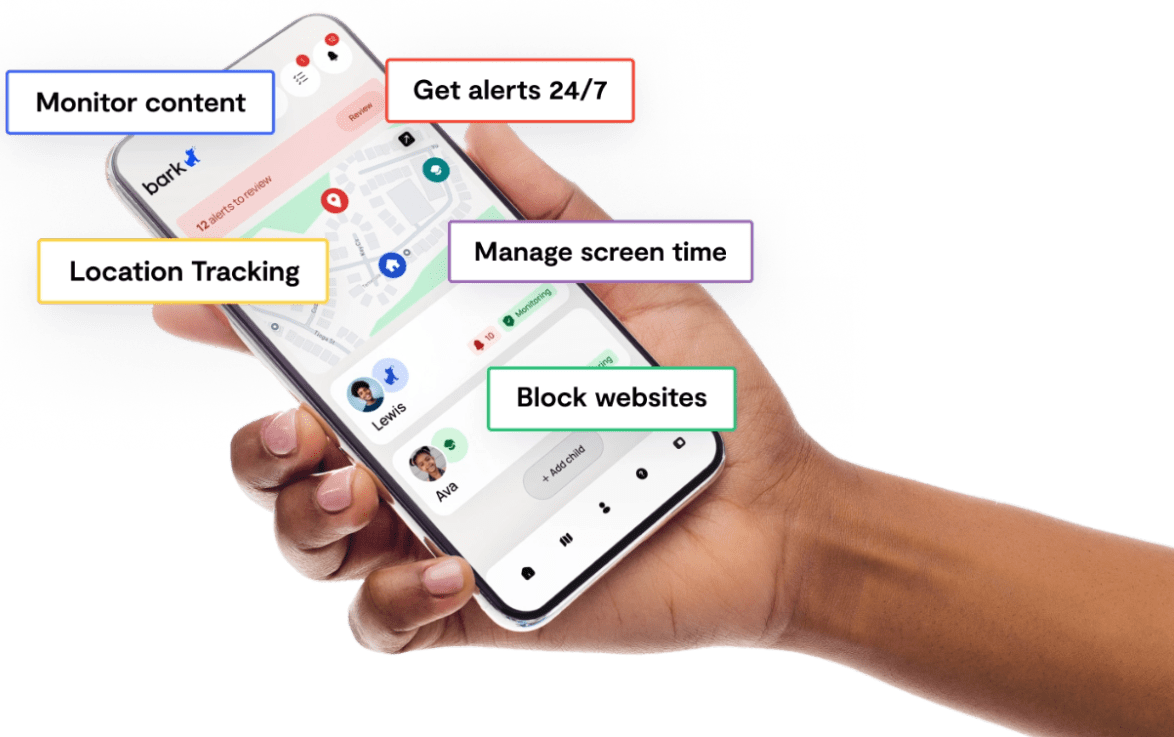 This “trust but verify” method has connected with more than 6 million families who want reassurance without reading through endless harmless messages about homework or memes.
This “trust but verify” method has connected with more than 6 million families who want reassurance without reading through endless harmless messages about homework or memes.
What truly sets Bark apart is its emphasis on fostering healthy digital habits. The app doesn’t just monitor – it guides. Parents receive conversation starters and expert-backed advice for handling difficult topics such as sexting or online harassment.
Many of these scripts are developed in collaboration with child psychologists, ensuring parents have practical tools for building trust while addressing serious issues. In addition, Bark provides screen time management and website blocking features, giving families a well-rounded safety net.
Key Insight: Research shows YouTube tops the list for cyberbullying risk, with 79% of kids reporting negative experiences, followed by 69% on Snapchat, 64% on TikTok, and 49% on Facebook. The likelihood of being bullied also rises as kids grow older, increasing by about 2% every two years between ages 10 and 18. Household income plays a role too – children from families earning under $75,000 are twice as likely to be bullied compared to those from higher-income households (22% vs. 11%).
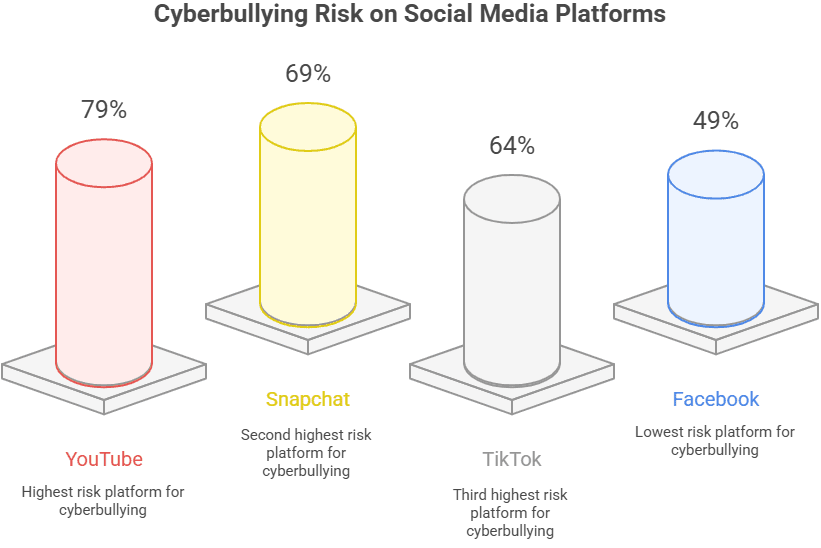
Batten Cyber recommends taking a holistic approach to family online safety. Aside from choosing the right monitoring app, consider implementing a family cybersecurity plan that covers everything from password security to recognizing online predator tactics.
What Is Qustodio? A Comprehensive Digital Supervisor
Qustodio takes a more traditional approach to parental controls, giving parents a full set of monitoring and management tools across devices. Since its launch in 2012, the Barcelona-based platform has become known for offering detailed oversight of children’s online activity.
Unlike Bark, which focuses on alerts and context, Qustodio provides granular visibility and stricter controls. Parents can review detailed activity reports, block apps or websites, enforce screen time limits, and track real-time location.
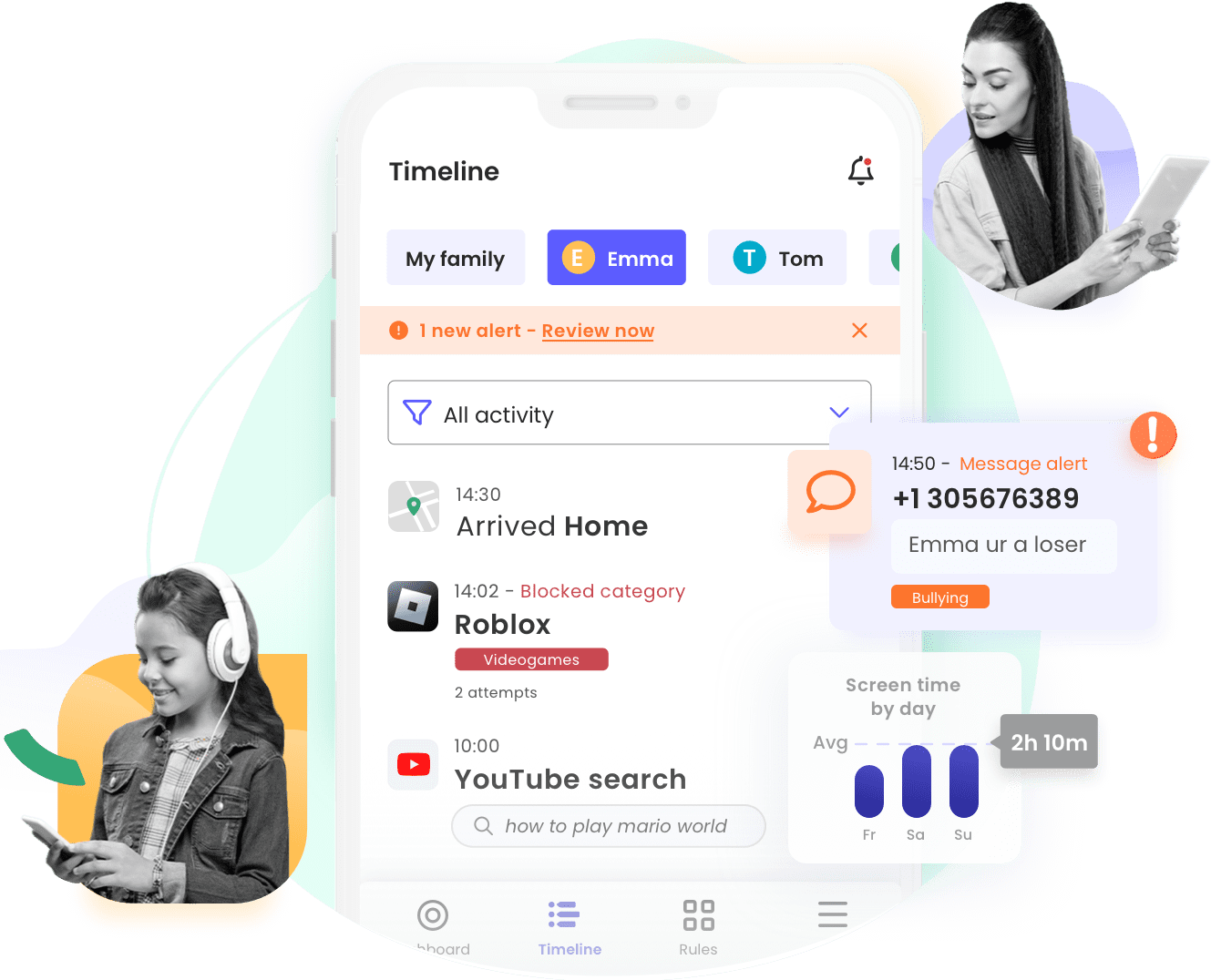
It works across all major operating systems and even allows Android parents to read SMS messages. This makes Qustodio particularly appealing to families who want maximum transparency and the ability to set hard boundaries. For households with multiple kids of varying ages, Qustodio’s customizable controls help tailor supervision to each child’s maturity level.
Key Insight: Sextortion is one of the most alarming risks children face online, and the data highlights its impact. About 1 in 5 teens report experiencing sextortion, with 81% of threats happening exclusively online. Among victims, 15% harmed themselves in response, and the rate was nearly triple for LGBTQ+ youth at 28% compared to 10% for their non-LGBTQ+ peers.
Many victims also reported revictimization: 18% said they sent more explicit images under pressure, while 17% were only 12 years old or younger when it first happened. Perhaps most concerning, 36% of victims actually knew their extortionist in real life, making the threats more psychologically damaging.

These findings highlight why Qustodio’s ability to block risky apps, filter communication, and give parents full visibility is critical. Its real-time monitoring, combined with scheduled restrictions, offers protection from both strangers and acquaintances who may exploit kids online.
When set up thoughtfully, Qustodio can provide the structure needed to prevent situations from escalating while also giving parents peace of mind.
Check out resources on child identity protection and social media safety measures to round out your family’s digital defense strategy.
Head-to-Head Feature Comparison: Where Each App Stands Out
When comparing Bark and Qustodio side by side, the differences in philosophy become clear. Both aim to keep kids safe online, but they take very different approaches.
Bark leans on AI-driven alerts that protect privacy while flagging serious issues, while Qustodio offers hands-on control and detailed visibility into every digital move.
Content Monitoring Capabilities
|
Feature |
Bark |
Qustodio |
| Platforms Monitored | 30+ including Discord, Spotify, Gmail, TikTok, YouTube, Snapchat | Primarily Facebook, Instagram, WhatsApp, plus call and SMS logs (Android) |
| Monitoring Method | AI scans for concerning text, image, and video patterns | Detailed activity logs, browsing history, and app reports |
| Alert System | Alerts only for issues flagged in 29+ safety categories | Real-time notifications of all activities |
| Social Media Coverage | Comprehensive, including DMs and saved media | Limited to major platforms |
| Email Monitoring | Yes, across multiple providers | Limited or none |
Bark’s AI is its secret weapon. It scans more than 30 platforms, catching issues in areas parents often overlook, like saved photos, Google Drive, or Discord group chats. It detects risks across 29 categories, from cyberbullying to drugs, predators, sexual content, and violence.
To date, Bark reports flagging more than 6.9 million bullying cases and 4.2 million severe self-harm situations, showing how powerful its detection system can be. Parents don’t sift through every message – they get alerts only when something truly matters.

Qustodio, on the other hand, thrives on transparency. It may cover fewer social apps, but it provides detailed reports about everything from YouTube history to search terms, along with SMS and call monitoring on Android. Parents who want full oversight will appreciate the clarity, though it can feel more invasive than Bark’s trust-based model.
Screen Time Management
Screen time controls highlight another philosophical divide. Bark offers light-touch tools, while Qustodio focuses on strict enforcement.
Qustodio’s Screen Time Features
- Set separate limits for educational vs. entertainment apps
- Create different schedules for school days vs. weekends
- Pause internet instantly during family meals or homework
- Automatically block devices when time runs out
- Track usage by app category and daily history
Bark’s Screen Time Features
- Custom schedules for internet access
- Bedtime controls for specific devices
- Ability to block certain apps or websites
- Designed to guide kids toward healthy habits rather than restrict them fully
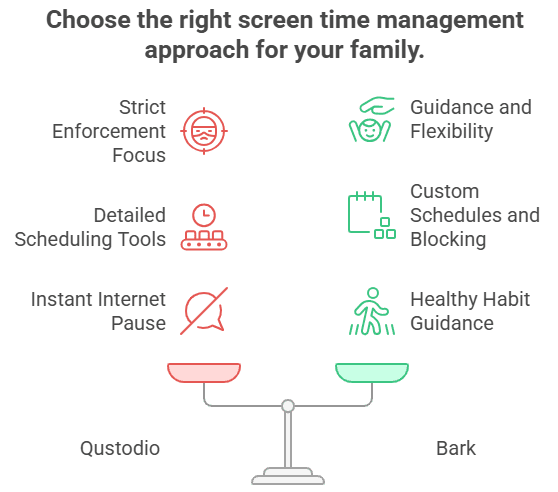
Qustodio’s strength lies in its structure. Parents can schedule rules that run automatically, making it ideal for families managing multiple children with different needs. Bark, by contrast, emphasizes balance. Its lighter touch works well for parents who prefer teaching digital wellness instead of locking down devices completely.
Location Tracking and Safety Features
Both apps offer GPS tracking, but again, their styles differ.
| Feature | Bark | Qustodio |
| Real-Time Tracking | Check-ins and on-demand requests | Always-on tracking |
| Location History | Limited history | 30-day history available |
| Geofencing | Simple alerts for arrivals/departures | Advanced custom zones |
| SOS Button | Not standard (Bark Watch includes it) | Yes, immediate alerts with location |
| Battery Use | Minimal impact | Moderate impact from constant tracking |
Qustodio excels in precision and detail. Parents can view a 30-day history of movements, set geofencing zones, and use the SOS button for emergencies. This always-on approach gives peace of mind but can feel heavy-handed.
Bark takes a middle ground. Parents can request check-ins, see location updates, and get alerts when kids arrive or leave certain places. It’s intentionally less invasive, aligning with Bark’s trust-first philosophy.
The Price Tag: What You’re Really Paying For
Let’s talk money, because these apps represent different value propositions at different price points.
Bark Pricing Structure
- Bark Jr: $5/month or $49/year
- Covers unlimited devices
- Basic monitoring (texts/emails)
- Screen time controls
- Web filtering
- Bark Premium: $14/month or $99/year
- Everything in Bark Jr
- 30+ social media platform monitoring
- Advanced web filtering
- Location alerts
- Unlimited devices
Qustodio Pricing Tiers
- Basic Plan: $54.95/year
- Up to 5 devices
- Core features only
- Web filtering
- Time limits
- Location tracking
- Complete Plan: $99.95/year
- Up to 10 devices
- All features included
- Calls & SMS monitoring
- YouTube monitoring
- Priority support
- Ultimate Plan: $137.95/year
- Up to 15 devices
- Everything in Complete
- Care Plus support
When evaluating price, consider what you’re actually getting. Bark Premium at $99/year covers unlimited devices and includes AI monitoring across 30+ platforms.
Qustodio’s comparable Complete plan at $99.95/year limits you to 10 devices but provides more granular controls. For large families or those with multiple devices per child, Bark’s unlimited approach might offer better value.
Key Insight: The average American household now has 21 connected devices. With 95% of teens having smartphone access and 45% online “almost constantly,” unlimited device coverage becomes crucial for comprehensive protection.
User Experience: The Parent and Child Perspective
The user experience often determines whether a parental control app becomes part of your daily routine or ends up abandoned after a few weeks. Ease of setup, dashboard design, and how the app feels for kids all play a role in long-term success. Bark and Qustodio again show their contrasting philosophies here.
Setting Up and Daily Use
Let’s see how easy each of these parental control apps are to set up and use on a daily basis.
Bark Setup Experience
- Streamlined installation process across iOS, Android, laptops, and the Bark Phone
- Step-by-step instructions with screenshots make connection simple
- Quick linking to social media and email accounts
- Clean, intuitive dashboard with alerts front and center
- Mobile app mirrors the web interface for easy use on the go
- Average setup time: 15-20 minutes
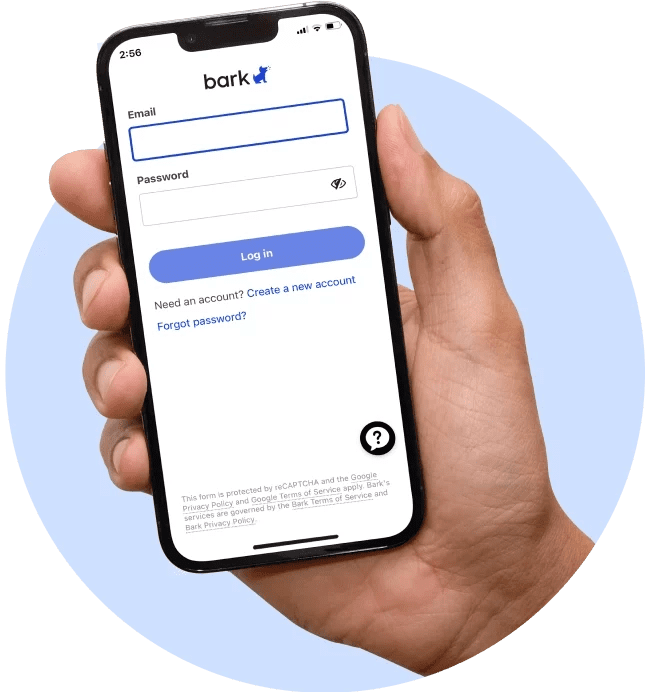
Qustodio Setup Process
- More detailed configuration during initial install
- Parents must create rules for screen time, app use, and web filters individually
- Dashboard filled with detailed usage charts and activity logs
- Multiple customization layers for each child’s device
- Steeper learning curve but high control once configured
- Average setup time: 30-45 minutes
Bark feels like a plug-and-play system designed for busy parents who want peace of mind without tech frustration. You connect accounts, set general rules, and the AI begins monitoring immediately. The dashboard is uncluttered and prioritizes alerts over raw data, which makes it easy to spot what matters most.
Qustodio, on the other hand, appeals to parents who prefer a high level of oversight. While setup takes longer, the reward is more granular control.
The dashboard shows charts for daily app usage, websites visited, search queries, and even YouTube history. This can feel empowering for detail-oriented parents but overwhelming for those looking for a quick setup.
The Child’s Experience
From the child’s perspective, Bark feels relatively invisible. Once installed, it runs quietly in the background. Kids won’t notice it day-to-day unless a screen time schedule kicks in or an app is blocked.
Because it only alerts parents when risks appear, teens often feel less “watched,” which reduces pushback and helps maintain trust.
Qustodio is harder to ignore. Kids will encounter blocked sites, apps shutting down at time limits, and sometimes a visible monitoring icon on their device.
This can be reassuring for younger children who need clear rules, but it often sparks resistance from older kids who value privacy. In some cases, tech-savvy teens may even look for workarounds, creating tension between parent and child.
For families, this difference is important: Bark emphasizes subtle monitoring with privacy in mind, while Qustodio enforces boundaries with firm visibility. Parents should choose based on whether they want cooperation through trust or compliance through structure.
Device Compatibility: What Works Where
Before committing to Bark or Qustodio, it is important to confirm that the app fits your family’s mix of devices. While both platforms support most major operating systems, the feature sets are not identical. Each app has strengths and limitations depending on whether your household runs on iOS, Android, or a combination of desktop and mobile devices.
Platform Support Comparison
| Platform | Bark Support | Qustodio Support |
| iOS | Yes (with limitations) | Yes (with limitations) |
| Android | Full features | Full features |
| Windows | Yes | Yes |
| Mac | Yes | Yes |
| Chromebook | Yes | Yes |
| Kindle | No | Yes |
| Email Accounts | Yes (Gmail, Outlook, others) | Limited |
| Home WiFi | Yes (via Bark Home hardware device) | No |
Bark Compatibility and Limitations
Bark works with iOS, Android, Windows, Mac, and Chromebooks, plus it can monitor Gmail and Outlook accounts. A standout feature is Bark Home, a separate device that connects to your WiFi router and allows you to manage screen time, filter websites, and monitor activity across any internet-connected device in the household.
This makes it useful for managing smart TVs, gaming consoles, and devices that don’t support the Bark app directly.
That said, iOS devices come with restrictions. Bark cannot scan iMessages or standard SMS texts on iPhones without using its companion “Bark for Kids” app.
Parents must install and configure this separately for more complete monitoring. Android devices, on the other hand, allow Bark to run with far fewer restrictions, providing broader access to texts, social media, and app activity.
Qustodio Compatibility and Limitations
Qustodio also supports iOS, Android, Windows, Mac, and Chromebooks, with one extra advantage: compatibility with Amazon Kindle devices, making it a solid choice for families where younger kids use Fire tablets.
Its monitoring features are more consistent across platforms compared to Bark, though – as with Bark – Apple restrictions limit what can be captured on iOS. For example, while Qustodio can monitor web use, apps, and screen time on iPhones, it cannot capture iMessages or every social platform’s private messages.
Unlike Bark, Qustodio does not offer a home network solution like Bark Home. Its controls are tied to the device itself, meaning smart TVs and consoles fall outside its reach unless managed through router-level settings provided by another system.
Still, Qustodio does not require a companion child app on iOS for basic functionality, which simplifies the setup for families using Apple devices.
Which Families Should Choose Which App?
After testing both apps and gathering feedback from parents, clear patterns emerge about which families benefit most from Bark and which thrive with Qustodio. The right choice depends on your children’s ages, your parenting style, and what digital risks concern you most.
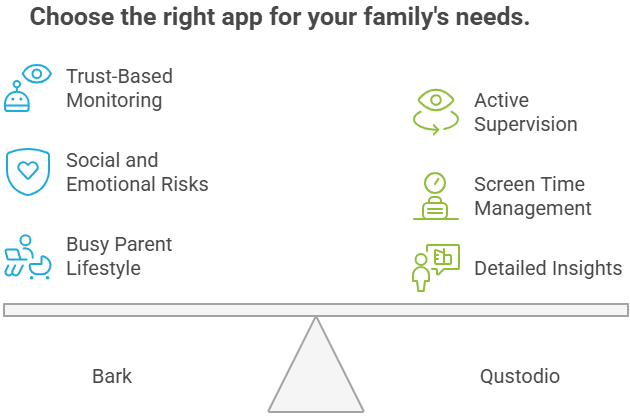
Choose Bark If Your Family Values:
- Trust-Based Monitoring: Bark is best for families that want protection without constant surveillance. It runs quietly in the background, scanning for risks and only alerting you when there is something you should know. This makes it ideal for teens who have earned some digital independence and for parents who want to respect privacy while still staying informed. Families with open communication in place often find Bark easier to integrate into daily life.
- Protection from Social and Emotional Dangers: If your biggest concerns are cyberbullying, depression, grooming, or exposure to harmful content, Bark’s AI-driven alerts are tailored for you. It scans across more than 30 platforms, including apps like Discord, Snapchat, and TikTok that often slip through the cracks of traditional parental controls. Rather than counting minutes of screen time, Bark focuses on the quality and safety of interactions.
- Busy Parent Lifestyle: For parents who don’t have time to review detailed activity logs every day, Bark’s alert system saves time by flagging only potential problems. It covers a wide range of platforms, email accounts, and even home WiFi through Bark Home. This “set it and trust it” model fits families with packed schedules who still want to know when something truly important happens.
Choose Qustodio If You Need:
- Active Supervision and Control: Qustodio works best for younger kids, typically under age 12, who need more structure and clear boundaries. It shows you exactly what apps your child is using, what sites they visit, and even their text messages and call history (on Android). Parents who want to see everything – not just alerts – will prefer Qustodio’s detailed logs and full-device visibility.
- Strict Screen Time Management: If screen time is a constant battle in your house, Qustodio’s scheduling tools are a big advantage. Parents can set daily usage limits, block specific apps at homework time, or create custom routines for weekdays and weekends. Once limits are hit, the device automatically locks down, making it effective for kids struggling with gaming or social media overuse.
- Detailed Insights and Reporting: Qustodio appeals to parents who want data for every conversation. Its dashboard includes charts, history logs, and activity reports that can help you spot patterns and track progress over time. This evidence-based approach works well for families that want to connect screen habits to real-life outcomes and reinforce good digital behavior.
| Parenting Need | Bark | Qustodio |
| Respecting Teen Privacy | Runs quietly in the background, alerts only when issues arise. Teens can use devices normally without feeling constantly monitored. | Shows full activity logs, blocked sites, and app shutdowns. Kids are more aware of being monitored. |
| Managing Younger Kids | Limited usefulness for children under 12, since it focuses more on online risks than daily structure. | Best suited for younger kids who need strict boundaries and consistent supervision. |
| Cyberbullying and Emotional Safety | AI scans for warning signs like bullying, grooming, depression, and drug use across 30+ platforms. | Can block risky sites or apps but does not detect subtle language patterns or emotional red flags. |
| Screen Time Battles | Offers basic scheduling and bedtime controls but not app-specific limits. | Provides strict, customizable limits by app or category, plus routines for homework and bedtime. |
| Busy Parent Alerts | Sends only actionable alerts, saving time by filtering out harmless content. Great for parents who want quick updates. | Requires more hands-on review of daily reports and dashboards to stay informed. |
| Location Tracking | Check-ins and alerts available; lighter touch so kids don’t feel surveilled. | Always-on tracking with geofencing, 30-day history, and SOS button for emergencies. |
| Data-Driven Insights | Offers reports with expert recommendations but keeps them brief and actionable. | Provides detailed charts, timelines, and history logs to analyze habits over time. |
| Platform Coverage | Monitors texts, emails, and 30+ social platforms, including Discord, Snapchat, TikTok, and YouTube. | Covers fewer platforms but provides deeper device-level monitoring, including calls and SMS (Android). |
Identifying Your Buyer Type: Which Parent Are You?
Choosing between Bark and Qustodio often comes down to what type of parent you are and what digital challenges you face at home. Below are the main buyer types that capture different family situations, along with which app best fits each one.
The Worried First-Timer
Parents handing over their child’s first phone often feel a mix of pride and anxiety. You want your child to enjoy some independence, but you also worry about cyberbullying, predators, or exposure to inappropriate content. The challenge is finding protection without becoming too invasive.
Best Fit: Bark. Its AI-powered monitoring quietly scans messages, apps, and online activity, alerting you only when real risks appear. This builds a foundation of trust and healthy habits from the start without overwhelming you – or your child – with constant controls.
The Battle-Weary Veteran
For some parents, the early trust has already been broken. Maybe your child has stayed up gaming all night, been exposed to explicit content, or even hidden activity from you. At this point, strong boundaries matter more than subtlety.
Best Fit: Qustodio. It gives you strict controls like app blocking, web filtering, and screen time enforcement. The detailed reports let you see exactly where problems arise, making it easier to enforce rules and rebuild structure in your household.

The Multi-Kid Manager
Families with children of different ages face another challenge: what works for your 7-year-old is too restrictive for your 15-year-old. Managing devices across multiple kids can quickly spiral into chaos without the right system.
Best Fit: Qustodio. Its customizable profiles allow you to create different schedules, rules, and filters for each child. Younger kids can have tighter restrictions, while teens get more flexibility, all from one dashboard. This keeps peace in households where everyone is at a different stage of digital maturity.
The Privacy-Conscious Protector
If your kids are older and already value independence, too much control can backfire and erode trust. You want to protect them from real dangers like depression, sextortion, or cyberbullying, but you don’t want to read every text or block every app.
Best Fit: Bark. By only alerting you when something serious arises, it respects your teen’s privacy while giving you peace of mind. You remain informed about critical issues without creating daily battles over surveillance.
The Data-Driven Decision Maker
Some parents prefer to base decisions on facts, not gut feelings. You want measurable insights about your child’s screen time, app usage, and digital habits over time. This approach helps you spot trends, track improvement, and have evidence-based conversations with your kids.
Best Fit: Qustodio. Its comprehensive analytics and detailed timelines provide the hard data you need. From daily reports to long-term charts, it gives you the numbers to back up your parenting choices and set realistic goals for digital balance.
Performance in Practice: What Parents Are Saying

Beyond features and pricing, real-world performance matters most. Based on user reviews and parent forums, both apps have their strengths and weaknesses in daily use.
Bark Performance Highlights
- AI Accuracy: Parents report approximately 85% accuracy in threat detection
- False Positives: Occasional alerts for song lyrics or movie quotes
- Response Time: Alerts typically arrive within 5-10 minutes of concerning content
- Technical Issues: Some users report periodic disconnections from social media accounts
Key Insight: In FBI Operation Restore Justice (2025), 115 children were rescued and 205 predators arrested in just 5 days. Many cases began with social media contact – exactly what Bark’s AI monitors for suspicious adult-child conversations.
Bark users consistently praise the accuracy of AI alerts, with many parents sharing stories about catching serious issues they would have otherwise missed. One parent discovered their daughter was being groomed by an adult posing as a teenager, while another received alerts about their son’s suicidal thoughts in time to get help.
The app’s biggest criticism involves technical glitches with social media connections that occasionally require re-authentication.
Qustodio Performance Metrics
- Blocking Reliability: 95%+ effectiveness in enforcing limits
- Location Accuracy: GPS tracking within 10-20 feet typically
- Battery Impact: 10-15% additional drain reported on mobile devices
- False Blocks: Educational sites occasionally caught in filters
Qustodio earns high marks for reliability in enforcing screen time limits and web filtering. Parents appreciate knowing the rules they set will be consistently applied.
Common complaints focus on the app occasionally blocking educational content or legitimate websites, requiring manual whitelist adjustments. Some users also report battery drain on mobile devices, though recent updates have improved this issue.
Privacy and Trust: The Elephant in the Room
No parental control tool can escape the tension between safety and privacy. Parents want to keep kids safe, but teenagers also need space to build independence and trust. Bark and Qustodio approach this balance in very different ways.
Bark’s Privacy Philosophy
- Surfaces only concerning content rather than every interaction
- Preserves normal peer conversations without parental review
- Helps avoid the temptation for over-monitoring
- Builds trust by being clear about what is and isn’t monitored
Qustodio’s Visibility Approach
- Shows complete activity across platforms
- Leaves little room for secrets between parent and child
- Requires open discussions to avoid damaging trust
- Works best when rules are created together as a family
Bark’s model appeals to families that already prioritize communication. Kids can complain about teachers, text about crushes, or share memes without constant oversight, knowing parents only see alerts if there is genuine concern. This creates a more natural digital environment and can reduce secrecy or rebellious workarounds.
Qustodio, on the other hand, appeals to parents who want complete visibility. This can be effective with younger children who need firm boundaries, but with teens, it works best when paired with honest conversations. Families that explain why monitoring is in place and involve kids in setting expectations often report better success.
Key Insight: Pew Research reports that 71% of parents worry about screen time, while 74% of teens say social media helps them feel more connected to friends. The challenge for parents is to strike the right balance between keeping children safe and allowing them to build the connections they need for healthy development.
Final Verdict: Our Comprehensive Comparison
After testing both apps and reviewing feedback from real families, here’s how Bark and Qustodio stack up across the most important categories:
| Category | Bark | Qustodio | Winner |
| AI Monitoring | Advanced AI scans texts, images, audio, and videos for nuanced threats across 29+ categories | Relies on keyword detection and activity logging, less context-aware | Bark |
| Platform Coverage | Monitors 30+ platforms including Discord, TikTok, YouTube, Gmail, and Spotify | Focuses on major platforms like Facebook, Instagram, and WhatsApp | Bark |
| Screen Time Control | Basic scheduling with bedtime and internet pause options | Granular, app-by-app limits, custom schedules, instant pause, and automatic lockouts | Qustodio |
| Activity Reports | Sends alerts only when issues arise, keeps parents from sifting through harmless content | Provides full daily and weekly reports, detailed timelines, and app usage graphs | Qustodio |
| Location Tracking | Check-in requests and location alerts; less invasive approach | Real-time GPS, 30-day history, geofencing, and SOS button for emergencies | Qustodio |
| Ease of Use | Simple, intuitive dashboard with quick setup (15–20 minutes) | Feature-rich but more complex dashboard, longer setup (30–45 minutes) | Bark |
| Privacy Balance | Surfaces only concerning content, protecting normal conversations | Complete transparency, shows all activity; better for younger kids | Bark |
| Price for Large Families | Flat pricing covers unlimited devices per family | Premium plans priced per device, costs rise with multiple children | Bark |
| iOS Functionality | Limited by Apple’s restrictions; requires companion app for some features | Limited by Apple as well, but no companion app needed for basics | Tie |
| Customer Support | Offers email and chat support, response times vary | Provides phone, email, and chat support with Care Plus add-on | Qustodio |
| False Positives | Occasionally flags harmless lyrics or memes | Sometimes blocks legitimate educational content requiring whitelisting | Tie |
| Customization Options | Less granular, focuses on alerts and guidance | Highly customizable with app-specific rules, routines, and time controls | Qustodio |
| International Availability | Primarily US-based with growing global adoption | Broad international reach, with support in multiple languages | Qustodio |
Making the Final Decision
Parental control apps are not optional but essential for protecting children online. Bark and Qustodio each provide valuable solutions, though they differ in philosophy. Bark’s AI-driven monitoring delivers effective protection while respecting privacy, making it a strong choice for families with teens who value trust.
Qustodio, on the other hand, excels at strict oversight and structured boundaries, which is often better suited for younger children or households that need firm screen time management. Both apps fill critical roles in addressing cyberbullying, sextortion, and online predators, challenges that continue to rise year after year.
Your decision ultimately depends on your family’s needs, parenting style, and the balance you want between safety and independence. To simplify that decision, Batten Cyber offers expert-vetted parental control solutions, helping you choose confidently and keep your family safe.
Ready to take action? Explore Batten Cyber’s curated selection of family safety solutions at Batten Safe’s Parental Controls marketplace, including exclusive deals on both Bark and Qustodio. Our security experts have vetted each option to ensure your family gets protection that actually works.
Frequently Asked Questions
How Does AI Monitoring in Bark Differ From Qustodio’s Approach?
Bark uses advanced AI that scans texts, images, and videos across 30+ platforms, flagging only concerning activity in 29+ categories. Qustodio focuses on complete transparency, providing detailed logs, activity history, and screen time reports. Bark’s model is less invasive and supports trust, while Qustodio’s method gives parents maximum visibility, making it particularly effective for younger children who need strict oversight.
Can Bark or Qustodio Detect Sextortion Threats?
Bark can detect suspicious patterns in conversations that may suggest grooming or sextortion attempts, sending parents alerts in near real-time. Qustodio helps by blocking risky apps, filtering communication, and providing detailed logs to identify threatening interactions. Neither app can prevent every threat, but both reduce risks when paired with open parent-child conversations and education about online predator tactics.
Which App Works Best for Families With Multiple Kids?
Qustodio generally works better for multi-kid households since it allows customized rules per child, such as strict limits for younger kids and more flexibility for teens. Bark is better suited for families with older children who value privacy and independence, as it focuses on alerts rather than constant oversight. Families with a mix of ages often use Qustodio to maintain different digital boundaries simultaneously.
How Do These Apps Handle Screen Addiction Risks?
Qustodio directly addresses screen addiction by enforcing strict app-specific limits, automatic lockouts, and daily routines. Bark takes a lighter approach, offering scheduling tools and bedtime controls without granular restrictions. Families with concerns about gaming addiction or excessive social media use often prefer Qustodio, while Bark fits families prioritizing emotional safety and digital wellness over strict time limits.
Are Bark and Qustodio Affected by iOS Restrictions?
Yes, both apps face limitations on iOS due to Apple’s restrictions. Bark requires a companion app for kids to enable full monitoring of messages, while Qustodio cannot capture iMessages but does provide app usage, web history, and screen time management. Android devices provide more complete monitoring for both apps, so families relying heavily on iPhones should expect reduced visibility.
How Can Parents Strengthen Digital Safety Beyond Using These Apps?
Parental control apps are an important tool, but they work best as part of a larger strategy. Families should also implement strong password practices, teach kids how to recognize online predators, and create rules around safe sharing of personal information. Monitoring for identity theft and teaching kids about phishing risks also help. Batten Cyber provides curated family cybersecurity solutions to make this process easier.
Sources
- The Cyberbullying Statistics You Need to Know in 2024
- Internet Crimes Against Children Task Force Program | Office of Juvenile Justice and Delinquency Prevention
- Cyberbullying: Twenty Crucial Statistics for 2025 | Security.org
- New data reveals the devastating toll of sextortion on kids – Thorn
- Average Number of Smart Devices in a Home 2025 | ConsumerAffairs®
- Teens, Social Media and Technology 2024 | Pew Research Center
- Office of Public Affairs | Justice Department Announces Results of Operation Restore Justice: 205 Child Sex Abuse Offenders Arrested in FBI-led Nationwide Crackdown | United States Department of Justice
- Parenting Kids in the Age of Screens, Social Media and Digital Devices | Pew Research Center




